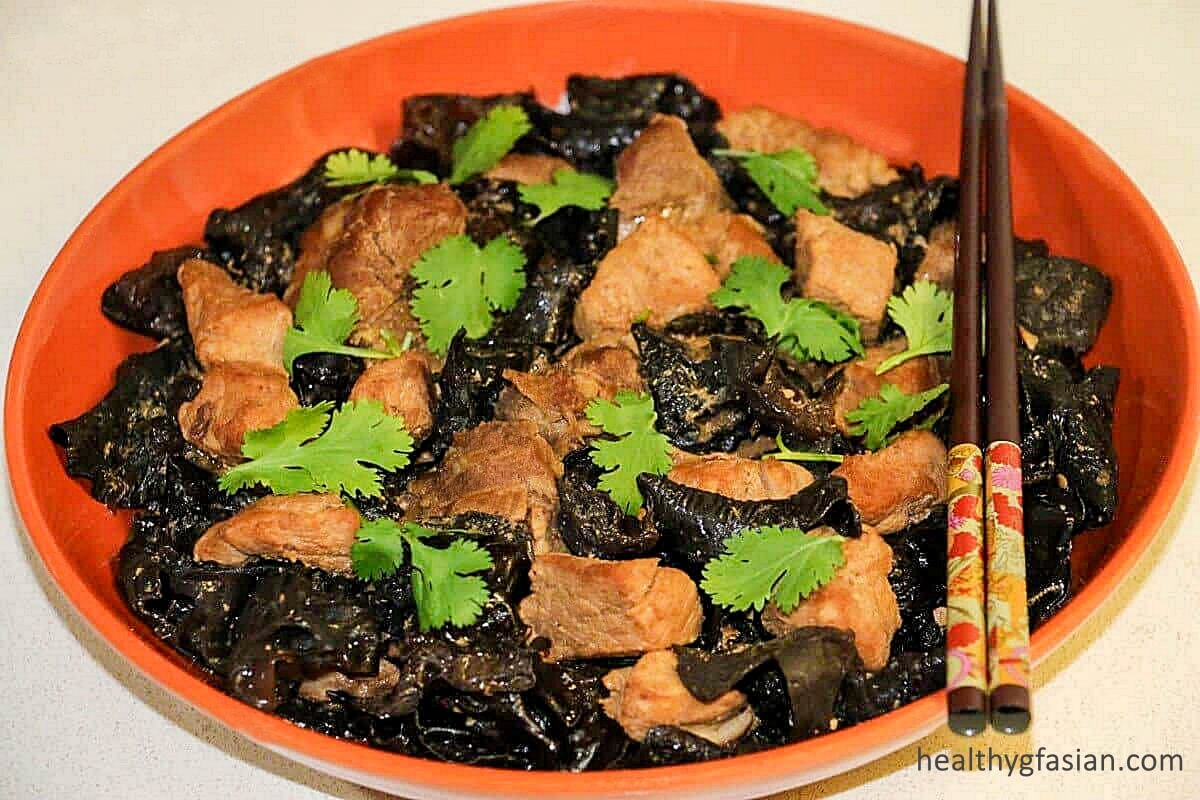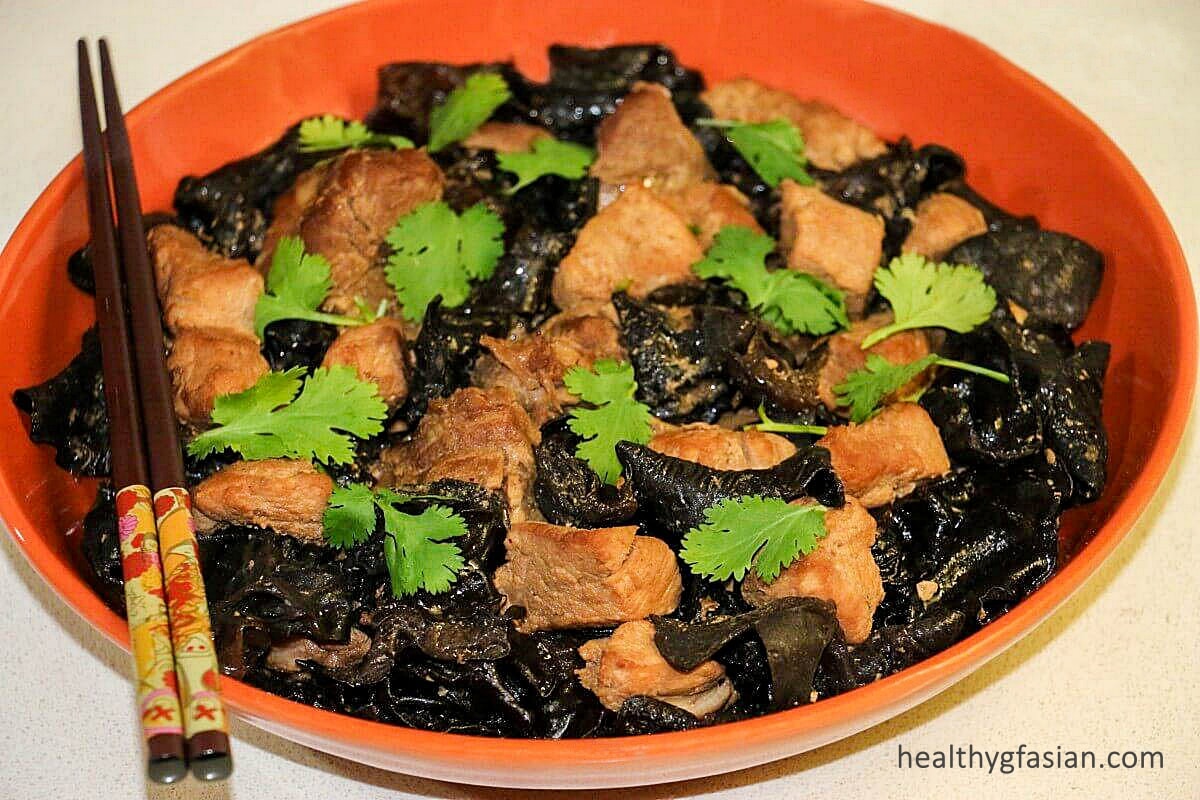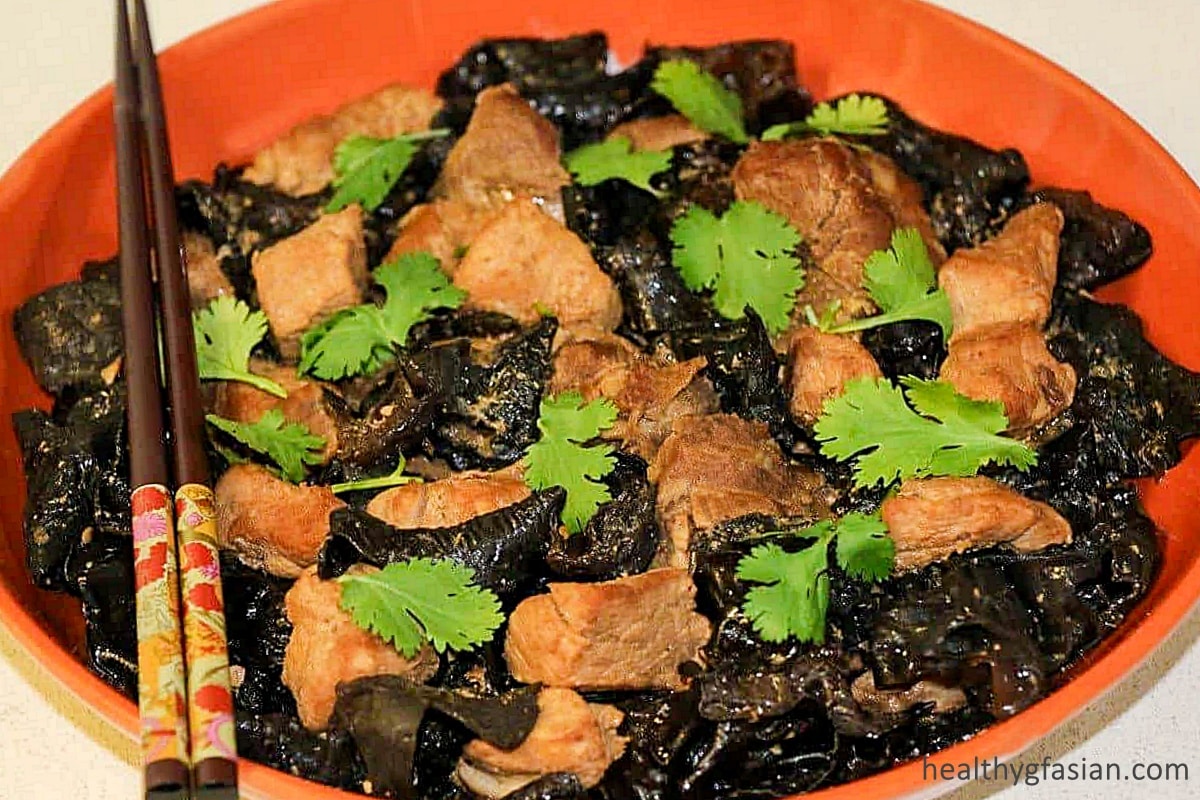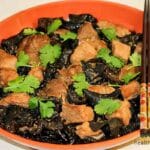The Hakka people created this pork and black fungus stew as a typical Hakka cuisine in the southeastern China. Namely, the Chinese regions of Fujian, Guangdong, Guangxi and Jiangxi. The original pork and black fungus stew recipe calls for deep frying of the marinated pork, normally pork belly. Then they add red fermented bean curd (often referred to as Chinese cheese) and five spice powder to the dish. Followed by stewing like a casserole dish.

Gluten Free Pork and Black Fungus Stew
For my gluten free pork and black fungus stew recipe, I have made some modification to the ingredients. I included lean pork leg and shoulder plus natural dried black fungus. And I replaced red fermented bean curd with gluten free hoisin sauce. Plus gluten free light soy sauce and gluten free kecap manis. As well as included spices like cloves and star anise. My gluten free pork and black fungus stew recipe is not only gluten free. But also corn free, dairy free, nut free, egg free and low carb.
Check out my other gluten free braised pork recipes:
- Instant Pot Braised Pork with Tofu;
- Braised Pork and Fermented Mustard Green; and
- Braised Pork and Hard Boiled Eggs.

About Black Fungus
Black fungus (Auricularia polytricha), also identified as Chinese black fungus mushroom. As well as cloud ear, wood ear fungus, ear fungus and tree fungus. They grow in groups in tropical and subtropical deciduous forests and damp forests on decomposing branches and twigs. Indigenous to Asia and some Pacific islands. Black fungus is dark brown to black in colour. Besides, they sell them as dried black fungus and need to rehydrate with water before cooking.
Culinary Uses of Black Fungus
Furthermore, they use black fungus as a widespread edible mushroom in Chinese cooking. Most commonly, they use it in hot and sour soup in Chinese restaurants all over the world. Likewise, they usually add black fungus for its crunchy texture as it has no taste by itself. But will take in all the flavourings added in cooking. Most frequently, they use black fungus in stews (braises and casseroles), soups, salads, stir-frys and as stuffing for spring rolls. My preference is to use natural black fungus because it grows naturally in the wild. As well as much smaller in size and has a smooth and crunchy texture and no woody parts.

Nutritional Values and Health Benefits of Black Fungus
Many people claimed that eating black fungus has numerous health benefits. Likewise, they hailed it as a naturally healing food or superfood similar to shiitake mushrooms. It is rich in protein equivalent to meat and has high level of iron. An excellent source of calcium and also abundant in vitamin B1 (thiamine), vitamin B2 (riboflavin) and vitamin D. In traditional Chinese medicine, practitioners use black fungus as remedies for haematemesis (vomiting of blood due to acute gastrointestinal bleeding). As well as cleansing of toxic matters from the body, anemia caused by iron deficiency andfor boosting blood circulation. As well as treatments for constipation, haemorrhoids, heart diseases and high blood pressure, plus the prevention of cancer.
In addition, it also helps detoxify the body. Because it forages and cleanses the digestive system with its distinctive pectin by absorbing any impurities in the digestive system. If you work or live in a polluted environment. It will be beneficial for your health to consume black fungus on a regular basis. New studies also revealed that black fungus is an anti-coagulant. Successful in reducing LDL cholesterol (“the bad cholesterol”) and atherosclerosis (thickening and hardening of the arteries).
Pork and Black Fungus Stew
Ingredients
- 5 tablespoons extra virgin olive oil
- 5 cloves garlic peeled and finely minced
- 600 g skinless and boneless pork leg trimmed and roughly cut into 1.2 inch pieces
- 600 g skinless and boneless pork shoulder trimmed and roughly cut into 1.5 inch pieces
- 100 g dried natural black fungus
- 2 star anise
- 10 cloves
- ½ cup water
- steamed basmati rice to serve
For the Sauce:
- 2 tablespoons gluten free light soy sauce
- 6 tablespoons gluten free kecap manis
- 5 tablespoons gluten free hoisin sauce
- 2 tablespoons medium dry sherry
For the Garnish:
- 3 sprigs coriander including stems (cilantro) including stems roughly cut into 2 cm (0.8 inch) lengthwise
Instructions
For Preparing The Black Fungus:
- To prepare the black fungus, soak them in hot water until rehydrated and soften. Wash black fungus and drain water and set aside. Cut each black fungus into 2 inch pieces if using larger size wood ear fungus, remove any woody parts.
Method 1: Using An Instant Pot Pressure Cooker Function
- Heat up an instant pot with 5 tablespoons of extra virgin olive oil and stir-fry the garlic on low heat until lightly golden.
- Add in all the pork pieces, stir-fry for 5 minutes on high to medium heat. Then add in all the black fungus, the sauce prepared earlier plus the water and stir-fry for another 10 minutes.
- Cover the pressure cooker and lock lid. Once pressure is attained, reduced heat to low. Cook for 20 minutes. Turn off heat. Let the pressure cooker rest for another 10 minutes, carefully release pressure. Unlock lid.
- Garnish with coriander and serve with basmati steamed rice.
Method 2: Stove Top Cooking
- Heat up a medium pot with 5 tablespoons of extra virgin olive oil and stir-fry the garlic on low heat until lightly golden.
- Then add in all the pork pieces, stir-fry for 5 minutes on high to medium heat. Add the sauce prepared earlier plus the water and stir-fry for another 10 minutes. Cover with lid and bring to the boil and simmer the pork for 1 hour on low heat.
- Add the black fungus, stir-fry and mix well with the pork and sauce, bring to the boil and cover with lid again and simmer on low heat for another 30 minutes or until pork is soft and tender.
- Garnish with coriander and serve with steamed basmati rice.






